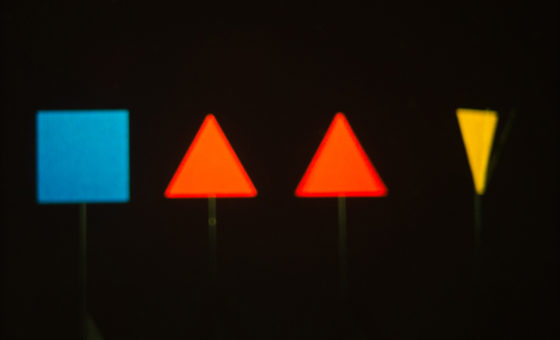
> Liliane Lijn (eeuu)
Liquid Reflections, Series one
1967
Tambor acrílico giratorio conteniendo agua, lámpara y bola acrílica.
Tambor acrílico que contiene: agua, plato giratorio, proyector, amplificador y bolas acrílicas.
Pertenece a la serie de obras más complejas con agua y luz. Inspirada en su interés por la astronomía y la física de la luz, fue el resultado de 5 años de trabajo experimental con plásticos y fuego, polímeros acrílicos, lentes, prismas, luz y, finalmente, agua.
Se compone de un disco acrílico hueco, que contiene agua y gira en un plato giratorio motorizado. En su superficie, dos bolas acrílicas giran, su movimiento está sujeto a fuerzas opuestas: la fuerza centrífuga del giro del disco y la fuerza centrípeta debido a la concavidad de la superficie del disco.
Cuando el agua se vierte por primera vez en el disco, se condensa en patrones que se asemejan a nubes de gas interestelares, pero pronto se contrae en gotitas esféricas precisas, vivas y temblorosas, que a su vez se vuelven cada vez más homogéneas, cubriendo toda la superficie del disco. El agua en el disco influye en el equilibrio total y es influenciada por él, ejerciendo un efecto sobre el movimiento de las bolas.
El movimiento de las bolas en la superficie del disco se rige por las leyes del momento, así como por la fuerza centrífuga y el tirón de la gravedad inducido por la concavidad del disco. Las bolas también actúan como lentes de aumento en movimiento, dándole vida a un área del disco, ahora a otra, con un extraño paisaje lunar de reflejos y sombras. Es el intento de Lijn de contemplar el universo en una escala íntima.
This piece belongs to a more intricate series of works centred around water and light. Inspired by her fascination with astronomy and the physics of light, it represents the culmination of five years of experimental exploration with plastics, fire, acrylic polymers, lenses, prisms, light, and, ultimately, water.
It consists of a hollow acrylic disc containing water, revolving on a motorized turntable. Two acrylic balls rotate on its surface, their motion influenced by opposing forces: the centrifugal force generated by the disc’s spin and the centripetal force due to the concavity of the disc’s surface.
As water is poured onto the disc, it initially condenses into patterns resembling interstellar gas clouds. However, it soon coalesces into precise spherical droplets, vibrant and trembling, before gradually forming a uniform layer that covers the disc’s entire surface. The water’s presence on the disc both affects the overall equilibrium and is affected by it, influencing the movement of the balls.
The motion of the balls across the disc’s surface adheres to the laws of momentum, as well as the centrifugal force and gravitational pull facilitated by the disc’s concavity. Additionally, the balls serve as dynamic magnifying lenses, illuminating different areas of the disc in a peculiar lunar landscape of reflections and shadows.
Liquid Reflections represents Lijn’s endeavour to contemplate the universe on an intimate scale.
Obra de la Colección INELCOM.


